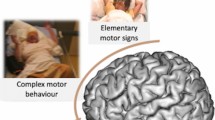Summary
Dipole source analysis was carried out in three adults and four children with 3 c/s generalized spike-wave (SW) discharges and absence seizures. Eighty-seven SW complexes were investigated. When one regional source was used the equivalent location was always near the baso-frontal area close to the midline. It explained on the average 89% of the variance in the adults and 82% in the children. When two regional sources were used and initially constrained for symmetry, the residual variance (RV) was reduced to 7% in the adults and 9% in the children. The sources remained in the frontal areas and were on the average 2 cm from the midline. When the mirror source was freed it remained contralateral in 76% of the complexes but moved ipsilaterally to various locations in the rest. To reduce the RV to between 2 and 3% one or two additional regional sources were required. These were located in the temporal or parietal areas in the adults and occasionally one occipital region in the children. The study showed that widespread and repetitive EEG events, like the generalized SW, can lend themselves to spatio-temporal multiple dipole modeling. More precise anatomic correlates may become possible with an expanded electrode array and the verification of their locations against the patient's MRI scan.
Similar content being viewed by others
References
Baumgartner, C, Sutherling, W.W., Shi Di and Barth D.S. Inves-tigation of multiple simultaneously active brain sources in the electroencephalogram. J. Neurosci. methods, 1989, 30: 175–184.
De Munck, J.C. The estimation of time varying dipoles on the basis of evoked potentials. Electroenceph. clin. Neurophysiol., 1990, 77: 156–160.
Ebersole, J.S. EEG dipole modeling in complex partial epilepsy. Brain Topography, 1991, 4: 113–123.
Jasper, H. Electroencephalography. In: W. Pervfield and H. Jasper (Eds.), Epilepsy and the Functional Anatomy of the Human Brain. Little, Brown and Co., Boston, MA, 1954: 625.
Nellhaus, G. Composite international and interracial graphs. Pediatrics, 1968, 41: 106.
Niedermeyer, E. The Generalized Epilepsies. Springfield, IL.; Charles C. Thomas, 1972.
Rodin, E. and Ancheta, O. Cerebral electrical fields during petit mal absences. Electroenceph. clin. Neurophysiol., 1987, 66: 457–466.
Rodin, E. and Cornellier, D. Source derivation recordings of generalized spike-wave complexes. Electroenceph. clin. Neurophysiol., 1989, 73: 20–29.
Rodin, E. and Rodin, M. Dipole sources of the human alpha rhythm. Brain Topography, in press.
Scherg, M. Fundamentals of dipole source potential analysis. In: F. Grandori, M. Hoke and G.L. Romani (Eds.), Auditory Evoked Magnetic Fields and Electric Potentials. Adv. Audiol, Karger, Basel, 1990, 6: 40–69.
Scherg, M. Functional imaging and localization of electromagnetic brain activity. Brain Topography, 1992, 5: 103–111.
Scherg, M. and Berg, P. Use of prior knowledge in brain electromagnetic source analysis. Brain Topography, 1991, 4: 143–150.
Scherg, M. and von Cramon, D. Evoked dipole source potentials of the human auditory cortex. Electroenceph. clin. Neurophysiol., 1986, 65: 344–360.
Scherg, M. and Picton, T.W. Separation and identification of event-related potential components by brain electrical source analysis. In: C.H.M. Brunia, G. Mulder, M.N. Verbaten (Eds.), Event Related Potentials of the Brain (EEG Suppl. No. 42) Elsevier, Amsterdam, 1991: 24–37.
Towle, V.L., Bolanos, J., Suarez, D., Tan, K., Grzeszczuk, R., Levin, D.N., Cakmur, R., Frank, S.A. and Spire, J.P. The spatial location of EEG electrodes: Locating the best fitting sphere relative to cortical anatomy. Electroenceph. clin. Neurophysiol., 1993, 86: 1–6.
Wong, P.K.H. Source modelling of the Rolandic focus. Brain Topography, 1991, 4: 105–112.
Author information
Authors and Affiliations
Additional information
The authors are grateful to Dr. Michael Scherg for his advice and constructive criticism.
Rights and permissions
About this article
Cite this article
Rodin, E.A., Rodin, M.K. & Thompson, J.A. Source analysis of generalized spike-wave complexes. Brain Topogr 7, 113–119 (1994). https://doi.org/10.1007/BF01186769
Accepted:
Issue Date:
DOI: https://doi.org/10.1007/BF01186769




